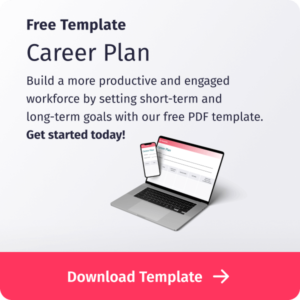No one wants to be stuck in a static position, especially a talented and ambitious group of professionals. More than high compensation, active job searchers want to work for companies that value career progression and development opportunities.
Aside from attracting applicants, perhaps there is talent in your organization that needs to shine.
Adequate career progression planning can help companies to uncover talent and combat unconscious bias in the workplace. Black Americans face a wage and promotion gap, leaving them overrepresented in low-wage jobs and underrepresented in executive positions. Women and LGBTQ employees also continue to face substantial wage disparities and obstacles to climb the career ladder.
In order to not perpetuate systemic inequality, diversity, equity, and inclusion must be a focus while addressing career progression. HR can play a role in actively combatting bias and ensuring fair career trajectories for all employees.
So, what does equitable career progression planning entail for HR? And what is the best way to structure a career progression plan?
- What is Career Progression?
- Diversity and Inclusion in Career Progression
- How to Create a Career Progression Plan
- HR Tools for Managing Career Progression
What is Career Progression?
Career progression is essentially how an employee moves forward in an organization. Advancement may consist of a salary increase or a change in title and responsibilities. In any case, career progression indicates opportunities for employees and encourages development and growth.
Employees may move through a series of positions throughout their careers. Both employer and employee need to have a mutual understanding of the direction and plan. For this reason, career progression plans are used to map out the course of an employee’s career.
Through evaluation and collaboration, HR professionals can work to establish a plan that fulfills the expectations of all parties.
Ensuring Diversity in Career Progression
Look to the makeup of those who hold higher positions in your company. Are they representative of a diverse workforce? Are there obstacles that could prevent team members from advancing their career paths?
Statistics indicate that black Americans are not being promoted nor paid according to their proportional educational and experiential skillsets. Everyone needs to work to eliminate structural barriers that prevent people of color, women, and LGBTQ employees from equitable career progression. So, how can HR do its part to encourage diversity and inclusion in the workplace?
- Uphold DEI in the company’s mission- Keep track of the outcomes of the company’s DEI initiatives. In what ways has the company made an effort to encourage career development for underrepresented employees? Show where the company struggles and the intended direction of growth.
- Include Employee Input- With all of the company’s diversity initiatives, it is essential to include employees throughout the process. Many team members who experience unconscious bias might feel as though the company’s DEI efforts are ineffective. Encourage employees to participate in finding better ways to tackle obstacles and achieve their career goals.
- Measure Employee Progress- Use reports and analytics to measure promotion and professional development. Are many underrepresented employees staying in the same position? Do the numbers reflect problems and bias in the workplace? Use the statistics to target and resolve problematic situations and policies.
- Promote Inclusive Policies- Allow employees to breastfeed, eliminate gender-specific dress codes, and allow time off for religious practices. Exclusive policies can damage employee’s psychological safety and ultimately prevent them from career advancement. Work towards making team members feel protected and supported by the company’s principles.
Everyone should be given the opportunity for advancement. But how can HR managers provide the framework for career progression? What do HR managers need to do to get started?
How to Create a Career Progression Plan
Career progression planning does not have to be complicated. Here are the steps to help you get started.
Determine Job Sequences
What is the next level of a position? What responsibilities does it entail? For employees to know how to move forward, there needs to be an easy-to-follow path in place.
For each position, expectations and responsibilities need to be crystal clear. Also, employees must have a solid understanding of what is required to advance to another role.
While defining the different roles and job sequences, flexibility is key. Because no two individuals are alike, it is important to offer more than one way to move forward. The goal is to help people make the most of their talents while progressing towards the company’s goals.
Collaborate with Employees
Before setting anything in stone, have a career consultation with employees to discuss their future development goals. Team members who actively participate in the planning process are more likely to feel engaged and integrated into the company.
In this one-on-one meeting, lay out the objectives of the business and ask employees to do the same. Do individuals have expectations of advancing to a senior-level position in 5 years? Would they like to make a lateral move into another department?
Find out and negotiate a middle ground. Once you are both on the same page, the foundation has been laid.
Indicate the Necessary Skills
Once sequences and goals have been defined, it is time to look at the nitty-gritty components of career progression planning. For every position, make a list of the skills and experiences necessary for success.
After making the list, brainstorm tactics to help employees develop their skillsets. Perhaps the company should invest in extra training sessions or mentorship programs. Special projects can be a unique opportunity for employees to learn new tools and tactics. HR managers can help to bridge skill gaps with a development plan for employees.
Review and Reexamine
How are team members coping with their new responsibilities? Are they frustrated or overwhelmed? Take note of all successes and struggles and offer support where it is needed.
It is always a good idea to meet with employees one on one to get feedback on career changes. HR managers might ask about the areas in which they feel the most confident and those in which they are struggling. It is always good to offer constructive suggestions to help employees overcome hurdles.
Adjustments are not always easy nor straightforward. Investing in additional training and development sessions might lead to long-term success.
How HR Can Manage Career Progression
Through career progression planning, human resources encourages employees to take ownership of their roles and contribute to the organization. Overall, HR’s efforts impact the comfort levels of individual employees and the tone of the company culture. Organizational and interpersonal skills are both necessary for successful career progression planning.
Talent needs to reach its full potential. HR needs to have the proper tools to help them do so.
The best way to gain insight into your workforce and balance responsibilities is with performance management software. Software helps human resources professionals easily see and keep track of employee development. It can help with all of the stages of decision-making and career progression management.
Successful HR professionals put people first and help them to achieve their goals every step of the way.




